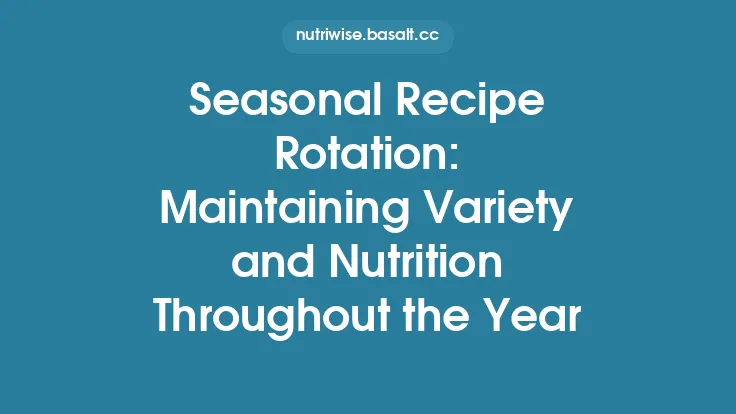Winter is the season when we instinctively reach for a steaming bowl to chase away the chill. While comfort is a key component of any soup or stew, the colder months also offer a bounty of nutrient‑dense produce that can turn a simple pot of broth into a powerhouse of health‑supporting compounds. In this article we’ll explore how to select, combine, and prepare winter vegetables, legumes, whole grains, and lean proteins so that every spoonful delivers warmth, flavor, and balanced nutrition. You’ll learn the science behind texture and nutrient retention, discover versatile flavor foundations, and find step‑by‑step guidance for a handful of adaptable recipes that can be customized to fit a variety of dietary preferences. By the end, you’ll have a reliable toolkit for building wholesome winter soups and stews that can anchor your meal‑planning strategy throughout the cold season.
Nutritional Highlights of Winter Produce
Winter vegetables are often richer in certain phytonutrients than their summer counterparts because they develop protective compounds to survive colder temperatures. Some notable examples include:
| Ingredient | Key Micronutrients | Health‑Supporting Compounds |
|---|---|---|
| Root carrots | β‑carotene (vitamin A), potassium | Carotenoids, polyphenols |
| Brussels sprouts | Vitamin C, folate, vitamin K | Glucosinolates (detoxifying) |
| Kale & collard greens | Vitamin K, calcium, iron | Flavonoids, lutein |
| Butternut squash | Vitamin A, magnesium | Beta‑cryptoxanthin |
| Parsnips | Vitamin C, manganese | Phenolic acids |
| Leeks & onions | Vitamin C, folate | Organosulfur compounds |
| Turnips & rutabagas | Vitamin C, potassium | Glucosinolates |
| Cabbage | Vitamin C, vitamin K | Anthocyanins (red varieties) |
| Winter beans (e.g., navy, lentils) | Protein, iron, folate | Resistant starch, soluble fiber |
These foods provide a blend of water‑soluble vitamins (C, B‑complex) that are relatively heat‑stable, as well as fat‑soluble carotenoids that become more bioavailable when cooked with a modest amount of healthy fat (e.g., olive oil, avocado oil). Incorporating a variety of these ingredients ensures a broad spectrum of antioxidants, anti‑inflammatory agents, and essential minerals that support immune function, skin health, and cardiovascular resilience during the colder months.
Building a Balanced Macronutrient Profile
A well‑crafted soup or stew can serve as a complete meal when it includes:
- Complex carbohydrates – Whole grains (farro, barley, quinoa) or starchy vegetables (sweet potatoes, squash) provide sustained energy and fiber.
- High‑quality protein – Legumes, lean poultry, fish, or plant‑based meat alternatives supply essential amino acids for tissue repair and immune support.
- Healthy fats – A drizzle of extra‑virgin olive oil, a spoonful of nut butter, or a handful of toasted seeds adds satiety and aids the absorption of fat‑soluble vitamins.
When designing a recipe, aim for a macronutrient distribution of roughly 45–55 % carbohydrates, 20–30 % protein, and 20–30 % fat. This range supports stable blood glucose levels while delivering enough protein to preserve lean mass—a particular concern for older adults who may experience age‑related muscle loss.
Core Flavor Foundations: Herbs, Spices, and Aromatics
Winter’s flavor palette leans toward warm, earthy, and slightly sweet notes. The following aromatics form a versatile base that can be tweaked to suit regional or cultural preferences:
| Category | Typical Use | Examples |
|---|---|---|
| Aromatics | Build depth from the start | Onion, leeks, garlic, celery root |
| Herbs (fresh or dried) | Brighten and balance richness | Thyme, rosemary, sage, bay leaf, parsley |
| Spices | Add warmth and subtle heat | Cumin, coriander, smoked paprika, nutmeg, cloves |
| Umami boosters | Enhance savory perception | Miso paste, fermented soy sauce, dried mushrooms, tomato paste |
A practical technique is to sweat aromatics in a small amount of oil over medium heat until translucent. This process releases volatile compounds without caramelizing, preserving a clean, sweet flavor that serves as a canvas for the rest of the ingredients. Adding spices after the aromatics have softened allows their essential oils to bloom, maximizing aroma without burning.
Techniques for Optimal Texture and Nutrient Retention
- Layered Cooking Times
- Root vegetables (carrots, parsnips, turnips) require 20–30 minutes to become tender. Add them early.
- Leafy greens (kale, collards) wilt within 5–7 minutes; stir them in near the end to preserve color and vitamin C.
- Legumes (pre‑soaked beans, lentils) need 15–25 minutes; if using canned, add them in the final 5 minutes to avoid over‑softening.
- Starch Gelatinization vs. Over‑Mushing
- When incorporating grains, bring the liquid to a gentle boil, then reduce to a simmer. This encourages starch gelatinization, thickening the broth naturally.
- Avoid vigorous boiling for extended periods, which can break down cell walls excessively, leading to a mushy texture and loss of water‑soluble nutrients.
- Collagen Extraction for Rich Mouthfeel
- Adding bone‑based stocks (chicken, beef, or fish) and simmering for at least 1 hour releases collagen, which converts to gelatin, imparting a silky body.
- For a vegetarian approach, use kombu (kelp) or mushroom stems, which contain polysaccharides that mimic the mouth‑coating effect of gelatin.
- Acid Timing
- Acidic ingredients (vinegar, citrus juice, tomatoes) can inhibit the softening of certain vegetables if added too early. Introduce them in the last 10 minutes to preserve texture while still allowing flavor integration.
- Preserving Heat‑Sensitive Vitamins
- Vitamin C and many B‑vitamins degrade with prolonged heat exposure. To retain the most, add a splash of freshly squeezed lemon juice or a handful of chopped parsley just before serving.
Sample Recipes with Step‑by‑Step Guidance
Below are three adaptable recipes that illustrate the principles discussed. Each can be scaled up for batch cooking or reduced for a quick weekday dinner.
1. Hearty Winter Root Vegetable & Barley Stew (Serves 6)
Ingredients
- 2 Tbsp extra‑virgin olive oil
- 1 large onion, diced
- 2 cloves garlic, minced
- 2 celery stalks, thinly sliced
- 2 carrots, peeled and cut into ½‑inch dice
- 2 parsnips, peeled and cut into ½‑inch dice
- 1 turnip, peeled and cubed (≈1 cup)
- ½ cup pearl barley, rinsed
- 6 cups low‑sodium vegetable stock (or chicken stock)
- 1 bay leaf
- 1 tsp dried thyme
- ½ tsp smoked paprika
- Salt and freshly ground black pepper, to taste
- 2 cups chopped kale, stems removed
- 1 Tbsp fresh lemon juice
- Optional garnish: toasted pumpkin seeds, fresh parsley
Method
- Sweat aromatics: Heat oil in a large Dutch oven over medium heat. Add onion, garlic, and celery; sauté 5 minutes until softened.
- Add spices: Stir in thyme, smoked paprika, and a pinch of salt; cook 30 seconds to release aromas.
- Introduce vegetables & barley: Add carrots, parsnips, turnip, and barley; toss to coat.
- Deglaze & simmer: Pour in ½ cup of stock, scraping the browned bits from the pot. Add remaining stock, bay leaf, and bring to a gentle boil. Reduce heat to a low simmer, cover, and cook 30–35 minutes, or until barley is tender and vegetables are fork‑soft.
- Finish with greens: Stir in kale; cook 5 minutes until wilted. Remove bay leaf.
- Season & serve: Add lemon juice, adjust salt and pepper. Ladle into bowls, garnish with pumpkin seeds and parsley for crunch and extra micronutrients.
Nutritional Insight
- Barley contributes soluble fiber (β‑glucan) that supports cholesterol management.
- Kale adds calcium, vitamin K, and lutein, while the lemon juice boosts vitamin C absorption of the iron from kale.
2. Spiced Lentil & Sweet Potato Soup (Vegan, Serves 4)
Ingredients
- 1 Tbsp coconut oil
- 1 medium onion, finely chopped
- 2 cloves garlic, minced
- 1 inch fresh ginger, grated
- 1 tsp ground cumin
- ½ tsp ground coriander
- ¼ tsp ground cinnamon
- ¼ tsp cayenne (optional)
- 1 large sweet potato, peeled and cubed (≈2 cups)
- 1 cup red lentils, rinsed
- 4 cups vegetable broth (low sodium)
- 1 cup canned diced tomatoes (no‑salt added)
- 2 Tbsp tomato paste
- 1 Tbsp apple cider vinegar
- Salt to taste
- Fresh cilantro, chopped (for garnish)
- 1 Tbsp Greek yogurt or coconut yogurt (optional, for creaminess)
Method
- Sauté base: Melt coconut oil in a heavy‑bottomed pot over medium heat. Add onion, garlic, and ginger; cook 4–5 minutes until fragrant and translucent.
- Toast spices: Sprinkle cumin, coriander, cinnamon, and cayenne; stir for 1 minute to awaken flavors.
- Add main ingredients: Incorporate sweet potato, lentils, broth, tomatoes, and tomato paste. Bring to a boil, then reduce to a simmer.
- Cook: Cover partially and simmer 20 minutes, or until lentils and sweet potato are soft.
- Blend (optional): For a smoother texture, use an immersion blender to puree half the soup, leaving some chunks for contrast.
- Finish: Stir in apple cider vinegar, which brightens the flavor and helps preserve vitamin C. Season with salt.
- Serve: Ladle into bowls, swirl a spoonful of yogurt if desired, and sprinkle cilantro.
Nutritional Insight
- Red lentils provide a complete protein profile when paired with the complementary amino acids in sweet potato.
- The combination of spices offers anti‑inflammatory compounds (cumin’s cuminaldehyde, ginger’s gingerols).
- Apple cider vinegar may aid in glucose regulation and enhances mineral absorption.
3. Chicken, Kale & Mushroom Winter Stew (Gluten‑Free, Serves 5)
Ingredients
- 2 Tbsp olive oil
- 1 lb skinless chicken thighs, trimmed and cut into 1‑inch pieces
- Salt and pepper, to season chicken
- 1 large onion, diced
- 2 cloves garlic, minced
- 8 oz cremini mushrooms, sliced
- 2 carrots, sliced diagonally
- 2 celery stalks, sliced
- 4 cups chicken bone broth (homemade or low‑sodium store‑bought)
- 1 cup diced butternut squash (≈½‑inch cubes)
- 2 cups chopped kale, ribs removed
- 1 tsp dried rosemary
- 1 tsp dried thyme
- ½ tsp smoked paprika
- 1 Tbsp miso paste (optional, for umami depth)
- 1 Tbsp fresh lemon zest (adds brightness)
Method
- Brown the chicken: Heat 1 Tbsp oil in a large pot over medium‑high heat. Season chicken with salt and pepper; sear until golden on all sides, about 5 minutes. Transfer to a plate.
- Sauté aromatics: Add remaining oil; reduce heat to medium. Cook onion, garlic, and mushrooms until the mushrooms release their moisture and begin to brown, 6–7 minutes.
- Build the stew: Return chicken to the pot. Add carrots, celery, butternut squash, rosemary, thyme, and smoked paprika; stir to combine.
- Add liquid: Pour in bone broth, bring to a gentle boil, then lower to a simmer. Cover and cook 25 minutes, or until chicken is cooked through and vegetables are tender.
- Incorporate greens: Add kale; simmer 5 minutes until wilted.
- Finish with umami and zest: Stir in miso paste (dissolved in a ladle of hot broth first) and lemon zest. Adjust seasoning with salt and pepper.
- Serve: Ladle into bowls, optionally drizzle a little extra‑virgin olive oil for added healthy fat.
Nutritional Insight
- Bone broth supplies collagen‑derived gelatin, supporting joint health and gut lining integrity.
- Miso adds probiotic benefits and deepens savory flavor without excess sodium when used judiciously.
- The lemon zest provides a burst of vitamin C, enhancing iron absorption from the chicken and kale.
Meal‑Planning Strategies for Winter Soups & Stews
- Batch Cooking & Freezing
- Prepare a large pot of stew (8–10 cups) and portion into freezer‑safe containers. Soups freeze well for up to 3 months; stews with higher fat content (e.g., bone broth) retain texture better.
- Label each container with the date and main protein source for quick rotation.
- Ingredient Pre‑Prep
- Roast a tray of winter root vegetables (carrots, parsnips, sweet potatoes) with a drizzle of oil and a pinch of salt. Store in the fridge for up to 5 days; they can be tossed into any soup for added depth.
- Cook a batch of whole grains (farro, barley) and keep refrigerated; they serve as a quick thickening agent and boost fiber.
- Balancing Meals
- Pair a bowl of soup with a side salad featuring raw winter greens (e.g., radicchio, endive) dressed in a vinaigrette. This adds texture contrast and ensures a broader micronutrient spectrum.
- For a complete lunch, include a protein‑rich snack such as a hard‑boiled egg, a handful of roasted chickpeas, or a slice of low‑fat cheese.
- Portion Control
- A typical serving of soup (≈1 ½ cups) provides roughly 200–300 kcal, making it ideal for weight‑maintenance plans. Adjust portion size based on activity level and individual energy needs.
Adapting Recipes for Specific Dietary Needs
| Dietary Goal | Simple Adjustments |
|---|---|
| Vegetarian | Replace animal‑based broth with mushroom or vegetable stock; add extra legumes or tofu for protein. |
| Vegan | Omit dairy‑based toppings; use coconut yogurt or cashew cream for richness. |
| Gluten‑Free | Choose gluten‑free grains (quinoa, millet) or increase the proportion of legumes; verify that any stock or miso used is gluten‑free. |
| Low‑Sodium | Use no‑salt broth, rinse canned beans, and rely on herbs, spices, and citrus for flavor. |
| Low‑FODMAP | Limit onions and garlic (use the green parts of scallions and garlic‑infused oil); choose low‑FODMAP vegetables like carrots, zucchini, and spinach. |
| High‑Protein | Double the legume portion, add a scoop of protein‑rich Greek yogurt, or incorporate shredded chicken/turkey. |
Sustainable Shopping and Waste Reduction
- Seasonal sourcing – Purchase winter produce from local farmers’ markets or community‑supported agriculture (CSA) shares. This reduces carbon footprint and ensures peak freshness.
- Whole‑plant utilization – Save carrot tops for pesto, beet greens for sauté, and mushroom stems for broth.
- Batch broth making – Collect vegetable trimmings (onion skins, carrot ends, celery leaves) in a freezer bag; once you have a cupful, simmer with water for a quick stock.
- Composting – Compost any inedible scraps to close the loop and enrich garden soil for next year’s harvest.
Final Thoughts
Winter soups and stews are far more than comfort foods; they are versatile vehicles for delivering a balanced mix of complex carbohydrates, high‑quality protein, healthy fats, and a rich array of micronutrients that support immunity, gut health, and overall vitality during the coldest months. By understanding the nutritional strengths of winter produce, applying sound cooking techniques that preserve texture and nutrients, and integrating thoughtful meal‑planning practices, you can turn a simple pot on the stove into a cornerstone of a health‑focused, seasonally attuned diet. Whether you’re feeding a bustling family, preparing meals for a busy workweek, or seeking nourishing options for specific dietary needs, the strategies and recipes outlined here provide a solid foundation for creating delicious, wholesome winter warmers that will keep you and your loved ones satisfied and thriving all season long.





